

Color conversion (RGB / CMYK / HSV / YUV / ...) Do you like these tools and you want to do something back?
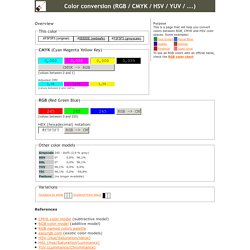
Desktop Surveillance — Sikuli X 1.0 documentation. Sikuli Script can be used to perform desktop surveillance.
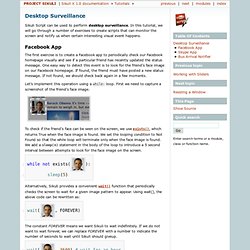
In this tutorial, we will go through a number of exercises to create scripts that can monitor the screen and notify us when certain interesting visual event happens. Facebook App The first exercise is to create a Facebook app to periodically check our Facebook homepage visually and see if a particular friend has recently updated the status message. One easy way to detect this event is to look for the friend’s face image on our Facebook homepage. If found, the friend must have posted a new status message. Let’s implement this operation using a while: loop. To check if the friend’s face can be seen on the screen, we use exists(), which returns True when the face image is found. 1while not exists( ): 2 sleep(5) Alternatively, Sikuli provides a convenient wait() function that periodically checks the screen to wait for a given image pattern to appear. 1wait( The constant FOREVER means we want Sikuli to wait indefinitely.
Geekfault. Imgur: the simple image sharer. Une alternative pratique : switch. En théorie, les structures à base de if… elseif… else que je viens de vous montrer suffisent pour traiter n'importe quelle condition.
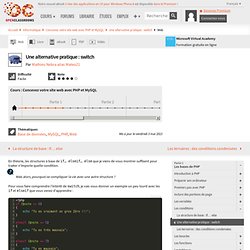
Mais alors, pourquoi se compliquer la vie avec une autre structure ? Pour vous faire comprendre l'intérêt de switch, je vais vous donner un exemple un peu lourd avec les if et elseif que vous venez d'apprendre : 1<? Php 2if ($note == 0) 4 echo "Tu es vraiment un gros Zéro !!! " 7elseif ($note == 5) 9 echo "Tu es très mauvais"; 12elseif ($note == 7) 14 echo "Tu es mauvais"; 17elseif ($note == 10) 19 echo "Tu as pile poil la moyenne, c'est un peu juste…"; HackingDNA. RDF2RDFa Converter. RDF2RDFa Converter by Roberto García, Martin Hepp, and Andreas Radinger What is it?
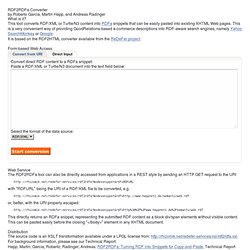
This tool converts RDF/XML or Turtle/N3 content into RDFa snippets that can be easily pasted into existing XHTML Web pages. This is a very convenient way of providing GoodRelations-based e-commerce descriptions into RDF-aware search engines, namely Yahoo SearchMonkey or Google. It is based on the RDF2HTML converter available from the ReDeFer project. Form-based Web Access Convert direct RDF content to a RDFa snippet: Paste a RDF/XML or Turtle/N3 document into the text field below: Select the format of the data source: Web Service The RDF2RDFa tool can also be directly accessed from applications in a REST style by sending an HTTP GET request to the URI with "RDFURL" being the URI of a RDF/XML file to be converted, e.g. or, better, with the URI properly escaped:
Downloads 38. This pages provides downloads of the DBpedia datasets.
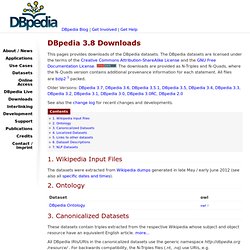
The DBpedia datasets are licensed under the terms of the Creative Commons Attribution-ShareAlike License and the GNU Free Documentation License. The downloads are provided as N-Triples and N-Quads, where the N-Quads version contains additional provenance information for each statement. All files are bzip2 1 packed. DBpedia Ontology The DBpedia ontology in OWL. Our JWS paper for more details. Ontology Infobox Types Contains triples of the form $object rdf:type $class from the ontology-based extraction. Ontology Infobox Properties High-quality data extracted from Infoboxes using the ontology-based extraction. Note that this data is of much higher quality than the Raw Infobox Properties in the /property/ namespace. Profil. Semantic Web. I have an idea that I think is very important but I haven’t yet polished to the point where I’m comfortable sharing it.

I’m going to share it anyway, unpolished, because I think it’s that useful. So here I am, handing you a dull, gray stone, and I’m saying there’s a diamond inside. Maybe even a dilithium crystal. My hope is that a few experts will see what I see and help me safely extract it. Or maybe someone has already extracted it, and they can just show me. The problem I’m trying to solve is at the core of decentralized (or loosely-coupled) systems. RDF offers a solution to this, but it turns out to be pretty hard to put into practice. Consider two on-the-web temperature sensors: The careful human reader will immediately wonder whether these temperatures are in Celcius or Fahrenheit, or if maybe the first is in Celcius and the second Fahrenheit. Here’s the first sketch of my solution: I know it looks ugly, but now it’s clear that both readings are in Fahrenheit. I’m not sure yet. No. Play.